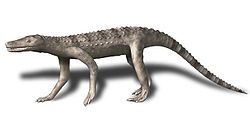- Dibothrosuchus
-
Dibothrosuchus
Temporal range: Early Jurassic
Life restoration of Dibothrosuchus elaphros Scientific classification 
Kingdom: Animalia Phylum: Chordata Class: Reptilia Superorder: Crocodylomorpha informal group: Sphenosuchia informal group: Sphenosuchidae Genus: †Dibothrosuchus
Simmons, 1965Type species †D. elaphros
Simmons, 1965Dibothrosuchus is a genus of sphenosuchian, a type of basal crocodylomorph, the clade that comprises the crocodilians and their closest kin. It is known from several partial skeletons and skulls. These fossils were found in Lower Jurassic rocks of Yunnan, China. Dibothrosuchus was a small terrestrial crocodylomorph that probably had a keen sense of hearing, and thus was likely a vocal animal like modern crocodilians.
History and description
Dibothrosuchus was named in 1965 by D.J. Simmons based on a partial skull and skeleton collected by Father Oehler of Fu Jen Catholic University from mudstones near the village of Dawa. The type species is D. elaphros.[1] Additional remains of this genus were recovered in 1985 by a joint Chinese-US expedition. Fossils of Dibothrosuchus come from the lower Lufeng Formation (the Dark Red Beds). At least three partial skeletons and two skulls are known, along with isolated bones.[2] Dibothrosuchus was first described as an ornithosuchid thecodont,[1] but it was later reclassified as a sphenosuchid sphenosuchian. A second species, D. xingsuensis, was named by Wu in 1986. After reexamination of the holotype Wu and Chatterjee found D. xingsuensis to be a synonym of D. elaphros, leaving only one species in the genus.[2]
 Vertebrae and limb bones of D. elaphros in the Field Museum of Natural History.
Vertebrae and limb bones of D. elaphros in the Field Museum of Natural History.
Dibothrosuchus was not a large animal. From the tip of the snout to the occipital condyle, the skull of IVPP V 7907 is only 164 millimetres (6.5 in) long, and the body length of the individual is estimated as 1.3 metres (4.3 ft). In general form, Dibothrosuchus was a slender, long-tailed and long-limbed quadruped with a pointed snout. Unlike modern crocodilians, it was a terrestrial animal. The upper jaws had five small teeth per premaxilla (snout-tip bones) and seventeen per maxilla, with a small hole between the maxilla and premaxilla for an enlarged tooth in the lower jaw to fit. At least eleven teeth were present on each side of the lower jaw. Several small ridges were present on the top of the skull. The various parts of the skull that supported hearing were well-developed, indicating that Dibothrosuchus had a keen sense of hearing and likely was a vocal animal that could communicate with others of the same genus, like modern crocodilians. Two rows of armor plates ran along the midline of the spine.[2]
References
- ^ a b Simmons, D.J. (1965). "The non-therapsid reptiles of the Lufeng Basin, Yunnan, China". Fieldiana, Geology 15: 1–93.
- ^ a b c Wu, Xiao-Chun; and Chatterjee, Sankar (1993). "Dibothrosuchus elaphros, a crocodylomorph from the Lower Jurassic of China and the phylogeny of the Sphenosuchia". Journal of Vertebrate Paleontology 13 (1): 58–89. doi:10.1080/02724634.1993.10011488.
Sphenosuchia Dromicosuchus · Hallopus · Hesperosuchus · Junggarsuchus · Kayentasuchus · Litargosuchus · Macelognathus · Pedeticosaurus · Phyllodontosuchus · Pseudhesperosuchus · Redondavenator · Saltoposuchus · Sphenosuchus · Terrestrisuchus · TrialestesProtosuchia Edentosuchus · Hemiprotosuchus · Neuquensuchus · Orthosuchus · Protosuchus · Shantungosuchus · Sichuanosuchus · Tagarosuchus · ZosuchusGobiosuchidae Shartegosuchidae Hsisosuchidae Related articles Related categories Terrestrial crocodiles · Triassic crocodylomorphs · Jurassic crocodylomorphs · Cretaceous crocodylomorphsCategories:- Prehistoric reptiles of Asia
- Jurassic crocodylomorpha
- Terrestrial crocodiles
Wikimedia Foundation. 2010.
